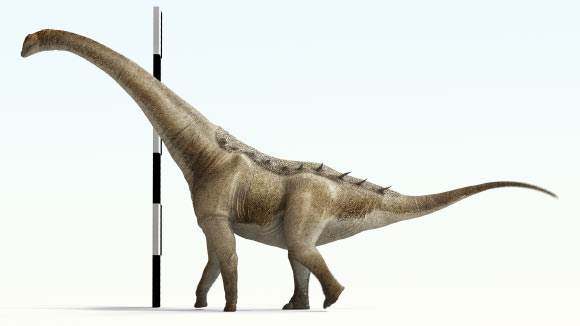Your basket is currently empty!

Paleontologists Discover New Species of Titanosaur in Spain
Top Stories Tamfitronics
Paleontologists have unearthed the skeletal remains from a previously unknown species of lithostrotian titanosaur at the fossil site of Lo Hueco, Cuenca, Spain.

An artist’s reconstruction of Qunkasaura pintiquiniestra. Image credit: José Antonio Peñas Artero.
Qunkasaura pintiquiniestra lived in Europe around 75 million years ago during the Cretaceous period.
The ancient creature was a member of Saltasauridae, a superfamily of titanosaurian dinosaurs within the clade Lithostrotia.
“Titanosauria was a successful group of sauropod dinosaurs that experienced an important event of diversification in the Early Cretaceous, with the establishment of several distinct lineages including Lithostrotia,” said University of Lisbon’s Dr. Pedro Mocho and his colleagues.
“Lithostrotians dominated the Late Cretaceous sauropod fauna and were represented by two main groups, the saltasauroids, and colossosaurs, including from small forms to the largest known land animals.”
“They survived until the Cretaceous-Paleogene boundary, when they became extinct as all other non-avian dinosaurs.”
The paleontologists uncovered an articulated and partially associated skeleton of Qunkasaura pintiquiniestra at the Lo Hueco site of the Villalba de la Sierra Formation in Cuenca, Spain.
“Qunkasaura pintiquiniestra stands out for being one of the most complete sauropod skeletons found in Europe, including cervical, dorsal and caudal vertebrae, part of the pelvic girdle and elements of the limbs,” they said.
“Their unique morphology, especially in the tail vertebrae, offers new insights into the non-avian dinosaurs of the Iberian Peninsula, a historically poorly understood group.”
The discovery reveals, for the first time, the presence of at least two distinct saltasauroid lineages in the Iberian region.
“One of these groups, called Lirainosaurinae, is relatively well known in the Iberian region and is characterized by small and medium-sized species, which evolved in an island ecosystem,” Dr. Mocho said.
“In other words, Europe was a huge archipelago made up of several islands during the Late Cretaceous.”
“However, Qunkasaura pintiquiniestra belongs to another group of sauropods, represented in the Iberian Peninsula by medium-large species around 73 million years ago.”
“This suggests to us that this lineage arrived in the Iberian Peninsula much later than other groups of dinosaurs.”
“We identify Qunkasaura pintiquiniestra as a representative of the opisthocoelicaudine saltasaurids, a group present in the northern hemisphere (Laurasia),” the researchers said.
“On the other hand, most Late Cretaceous sauropods from southwestern Europe, including Lohuecotitan pandafilandipreviously described from Lo Hueco, belong to Lirainosaurinae, a group of sauropods apparently exclusive to the European continent.”
“Our study suggests that Lo Hueco is the only place where the coexistence of both groups is known and proposes a new group of titanosaurs called Lohuecosauria, which includes representatives of both lineages.”
“Lohuecosaurs may have originated on the southern continents (Gondwana) before dispersing globally.”
The findings appear in the journal Communications Biology.
_____
P. Mocho et al. 2024. A Spanish saltasauroid titanosaur reveals Europe as a melting pot of endemic and immigrant sauropods in the Late Cretaceous. Commun Biol 7, 1016; doi: 10.1038/s42003-024-06653-0





Leave a Reply
You must be logged in to post a comment.